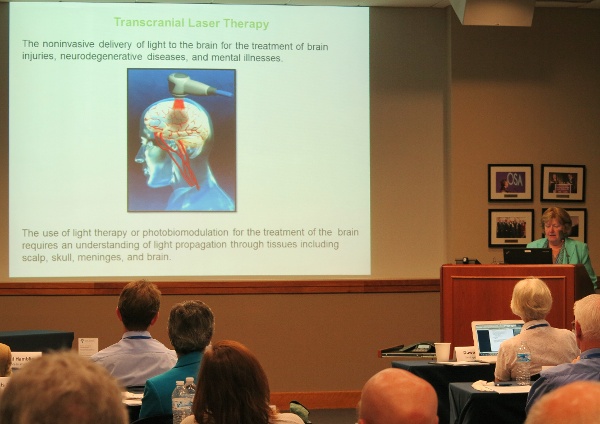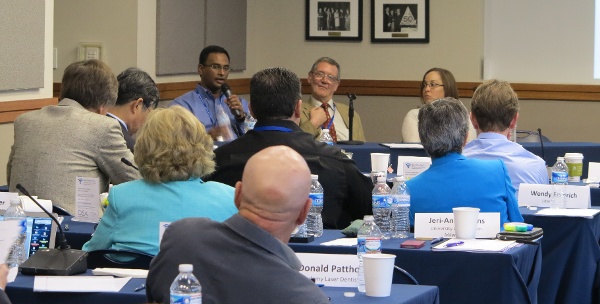Low-Level Light in the Clinical Setting
Elieza Tang
Traumatic Brain Injury (TBI) affects millions of people around the world and recently LLLT is becoming an alternative option for the treatment. The noninvasive nature of LLLT makes it an attractive treatment option with a potentially low risk of adverse events. Michael R. Hamblin, Wellman Center for Photomedicine, Massachusetts General Hospital, developed a TBI model in mice and used a neurological performance test to assess the severity of the brain injury. The results of his study showed that laser treated mice had smaller brain lesions compared to control. Michael’s research also looked at how repetitive laser treatment affects Michael’s data showed that LLLT increases neurotrophins, neurogenesis and synaptogenesis, while also reducing inflammation and apoptosis. There have also been clinical trials of light therapy for TBI that shows improvement in cognitive performance.
The next application of LLLT focuses on its use in autoimmune demyelination in multiple sclerosis by Jeri-Anne Lyons, University of Wisconsin-Milwaukee. Multiple sclerosis is an inflammatory, demyelinating disease of the central nervous system with variable amounts of axon damage occurring early in the disease, due to an inflammatory response along with toxic cytokines and ROS. Jeri-Anne’s disease model uses the experimental autoimmune encephalomyelitis (EAE) model. Her results showed that laser treatment decreased pro-inflammatory mediators, increased anti-inflammatory mediators and decreased apoptosis in central nervous system in the EAE mouse model.
For the final application presentation, Praveen Arany, National Institutes of Health, focused on answering two distinct questions 1). How can we make LLLT/PBM more robust and reliable? 2). Why focus on LLLT/PBM (PBM/toxicity) mechanisms? In order to properly use LLLT/PBM, one must understand the threshold when laser treatment crosses from stimulatory into the inhibitory range. The objective of Praveen’s research is to determine the threshold at which laser treatment becomes phototoxic or cytotoxic in order to safely administer laser treatment in the clinical setting. Like all treatments, it is crucial to understand any destructive or adverse effects. The conclusions from his research is that it is possible to use surface temperature during laser treatment as a clinical indicator of laser phototoxicity, there are molecular markers which are indicators of laser cytotoxicity, and through heat and ROS neutralization rescues laser cytotoxicity. By being able to identify clinical markers and biological markers of laser phototoxicity will be the beginning of outlining guidelines and addressing regulatory issues for administering safe laser treatment.
All three pre-clinical research presentations demonstrated impressive and exciting data showing the biostimulatory effects including anti-inflammatory effects, improving cognitive function and nerve regeneration in-vitro and in-vivo models along with some clinical trials.
Finally, yesterday wrapped up with a session on devices and dosimetry – a much needed topic to discuss. This is to establish a foundation for the safe and proper use of laser devices. The founder and CEO of THOR Photomedicine, Ltd. and one of the hosts, James Carroll, discussed issues with dosimetry due to variations in beam measurement and differences in units of dosage reporting. Beam areas are elliptical, with a Gaussian distribution with the center of the beam being the most powerful. In order to properly measure beam profile industry needs to come to an agreement of what is the best technique for beam area measurement to establish a standardized method.
Juanita Anders added that lasers require a certain amount of time to stabilize after being turned on to ensure that the power output is consistent. Her study showed that a 904nm super pulsed laser required ten minutes of time after being turned on to stabilize and it was only through experimentation that she realized this power output variation. The lesson is that it is important point to understand a laser device before using it and it reinforces the need for standardized protocol for proper usage of a laser device.
To wrap up the device session, Clark Tedford, LumiThera, Inc. discusses his PBM start up and laser device used to treat dry, age-related macular degeneration and possibly other ophthalmologic diseases for ocular improvement.
The dosimetry and devices session brings up key factors and issues that should be considered and discussed. As we are able to agree upon dosage parameters, wavelengths, and laser type for different clinical conditions it will provide a strong foundation and standardized protocol for proper laser treatment. As discussed earlier in the day, photobiomodulation can transition into photodynamic therapy, shifting biostimulatory responses to bio-inhibitory responses. To prevent the deleterious effects, it is crucial to establish rigid guidelines and reliable protocols, to pave the way for reducing clinical inconsistencies to improve patient care using LLLT.
Looking forward to the final day of this exciting Incubator!

Juanita Anders

Praveen Arany, Mike Hamblin and Jeri-Anne Lyons

James Carroll
